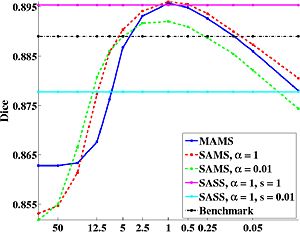Projects:SphericalDemons
Back to NA-MIC Collaborations, MIT Algorithms
We present the fast Spherical Demons algorithm for registering two spherical images. By exploiting spherical vector spline interpolation theory, we show that a large class of regularizers for the modified demons objective function can be efficiently implemented on the sphere using convolution. Based on the one parameter subgroups of diffeomorphisms, the resulting registration is diffeomorphic and fast -- registration of two cortical mesh models with more than 100k nodes takes less than 5 minutes, comparable to the fastest surface registration algorithms. Moreover, the accuracy of our method compares favorably to the popular FreeSurfer registration algorithm. We validate the technique in two different settings: (1) parcellation in a set of in-vivo cortical surfaces and (2) Brodmann area localization in ex-vivo cortical surfaces.
Contents
Description
Motivated by the spherical representation of the cerebral cortex, this work deals with the problem of registering spherical images. Cortical folding patterns are correlated with both cytoarchitectural and functional regions. In group studies of cortical structure and function, determining corresponding folds across subjects is therefore important.
Unfortunately, many spherical warping algorithms are computationally expensive. One reason is the need for invertible deformations that preserve the topology of structural or functional regions across subjects. In this work, we take the approach, previously demonstrated in the Euclidean space [2], of restricting the deformation space to be a composition of diffeomorphisms, each of which is parameterized by a stationary velocity field. In each iteration, the algorithm greedily seeks the best diffeomorphism to be composed with the current transformation, resulting in much faster updates.
Another challenge in registration is the tradeoff between the image similarity measure and the regularization in the objective function. Since most regularizations favor smooth deformations, the gradient computation is complicated by the need to take into account the deformation in neighboring regions. For Euclidean images, the demons objective function facilitates a fast two-step optimization where the second step handles the warp regularization via a single convolution with a smoothing filter [1,2]. Based on spherical vector spline interpolation theory and other differential geometric tools, we show that the two-stage optimization procedure of the demons algorithm can be efficiently applied on the sphere.
Experimental Results
Cortical Parcellation
[1] J. Thirion. Image Matching as a Diffusion Process: an Analogy with Maxwell’s Demons. Medical Image Analysis,
2(3):243–260, 1998.
[2] T. Vercauteren, X. Pennec, A. Perchant, and N. Ayache. Non-parametric Diffeomorphic Image Registration with the Demons Registration. In Proceedings of the International Conference on Medical Image Computing and Computer Assisted Intervention (MICCAI), volume 4792 of LNCS, pages 319–326, 2007.
Key Investigators
- MIT Algorithms: [| B.T. Thomas Yeo], Mert Sabuncu, Rahul Desikan, Bruce Fischl, Polina Golland
Publications
In Print
In Press
- B.T.T. Yeo, M.R. Sabuncu, R. Desikan, B. Fischl, P. Golland. "Effects of Registration Regularization and Atlas Sharpness on Segmentation Accuracy". Accepted to Medical Image Analysis, 2008.




